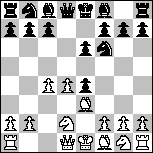DDG
Accepted
The only serious way to challenge a gambit is to accept it.
After 1.e4 e6 2.d4 d5 3.c4, brave fighters take the offered
pawn without hesitation: 3...dxe4!.
Naturally, 3...dxc4 would
transpose to the Queen's Gambit Accepted; all other moves form the
theory of the DDG Declined.
W

|
|
This is natural and by far the most played move. It may look like
White is intending 5.Nxe4, but that is hardly ever the case.
4.Be3 (Alapin-Diemer-Duhm)
The Alapin-Diemer Gambit (ADG)
games where the good old c4 is played later transpose to this
variation.
Especially the knight on d2 makes this variation unique; other lines
are dealt with the 4.Nc3 Nf6 5.Be3
variation.
I am a bit reluctant to the Nd2 lines, but DDGers cannot be purists:
the whole DDG is just a bunch of transpositions.
The following games and analysis are mainly from Tim Sawyer's
Alapin French - Tactics for
White.
1.e4 e6 2.d4 d5 3.Be3 dxe4 4.f3
exf3 5.Nxf3 Nf6 6.Bd3 Bd6 7.O-O O-O 8.c4 Nc6 9.Nbd2 Ng4 10.Bxh7+
Kh8 11.Ng5 Bxh2+ 12.Kh1 e5 13.Rxf7 exd4 14.Qf3 Re8 15.Rf1 Bd7
16.Rxg7 Kxg7 17.Qf7+ Kh8 18.Qh5 Kg7 19.Qg6+ 1-0,
Diemer - von Freytag, 1954
 .
.
4.Nd2 Nf6
A) 5.c4
B

- 5...c6 6.f3 exf3 7.Qxf3 Nbd7 8.O-O-O Be7 9.Bd3 e5 10.Nb3 Qc7
11.Qg3 Nh5 12.Qf3, 1-0 in 38,
Diemer - Johansson, 1958
(game 34 in Sawyer's book).
- 5...Nbd7 6.f3 c5 7.Qa4 Qc7 8.Ne2 cxd4 9.Nxd4 Be7 10.Nb5 Qc6
11.Nb3 exf3 12.N3d4, 1-0 in 29,
Diemer - Hunn, 1983
 .
.
- 5...Nc6 6.Ne2 e5 7.Qa4 Bd7 -/+ seems to best [Sawyer].
B) 5.f3
- 5...exf3 6.Ngxf3 b6 7.Bd3 Bb7 8.O-O h6 9.c4 = [Sawyer].
- 5...Nd5 6.Qe2 Nxe3 7.Qxe3 exf3 8. Ngxf3 Be7 9.Bd3 Nd7 10.O-O
Nf6 11.Ne5 O-O 12.c4 a5, draw in 57,
Cody - Terreaux,
Compuserve 1993 (game 47 in Sawyer's book).
12...b5 13.Nc6 Qd7 14.Nxe7+ Qxe7 15.Qh3 g6 (15...bxc4! 16.Nxc4
Rfd8 =) 16.Qf3 Nh5 17.Qxa8 1-0,
Rittenhouse - Peterson, NWPC
corr. 1991.
C) 5.Ne2 b6 6.Ng3
(6.a3 Bb7 7.c4 c5 8.dxc5 Bxc5 9.Bxc5 bxc5 10.Nc3 O-O -/+
[ECO])
6...Bb7 7.c4 Be7 (7...Nbd7 8.Qc2 Bb4 -/+ [Pachman]) 8.Be2 O-O
9.f3 exf3 10.Bxf3 Bxf3 11.Qxf3 Na6 12.O-O c5, 0-1 in 28,
Zaugg - Buffat, 1991.
4.f3?! most likely transposes to other variations. Besides, Black has
clear advantage after 4...Bb4+ 5.Nc3
c5!.
I have only "studied" the following original line:
4...f5 5.fxe4?!
- 5...Qh4+ 6.g3 Qxe4+ 7.Qe2 Qxd4 -/+ or 7...Qxh1 8.Nf3 +/-.
- 5...fxe4 6.Qh5+ g6 7.Qe5 Qf6 (7...Qe7? 8.Qxh8 Nf6 9.Bh6 +-)
8.Qxe4 unclear or 8.Qxc7? Nc6 -/+.
4...Bd6!? 5.Be3 Nh6 6.Bxh6 Qh4+ 7.Ke2 exf3+ 8.Nxf3 Qxh6,
0-1 in 36, Brause - Fuzzy, FICS 1996. Here Fuzzy, another program, is
more innovative; its rating is over 2400.
In general, other (good) moves transpose to more common variations.
- 4.Ne2 was suggested by Chessmaster 3000, and it has a clear idea:
after 4...Bb4+ 5.Nbc3 (5.Bd2 Nc6 6.Bxb4 was suggested by Rebel
Decade) Bxc3+, White can play 6.Nxc3, avoiding the doubled c-pawns.
However, Nge2 is only considered in variations 4.Nc3
Nf6,
4...Bb4 and
4...Nc6.
- 4.Bf4?! Nc6 (4...g5!? 5.Be5 f6, Blanco - Heikkinen, DDGA 1997)
5.Ne2 Nb4 6.Nec3 Qxd4 -+, 0-1 in 20,
Purdy - Angus, corr. 1996.
- 4.g3 is a positional approach to the DDG. This probably
transposes to 4.Nc3 f5, or
4...Nf6.
- 4.g4?! would be the Grob Attack Deferred.
4...e5 5.d5 Qh4 6.h3 Bc5 7.Rh2 h5 8.g5 Ne7 9.Nc3 Nf5 10.Qc2 e3
11.Nf3 exf2+ 12.Kd1 Qg3 13.Qe2 Nd4 14.Qxe5+ Qxe5 15.Nxe5 Bd6
16.Bf4 Bxe5 17.Bxe5 Nf3 18.Bxc7 Nxh2 19.Bxh2 O-O 20.Ne4 b5 21.c5
Rd8 22.d6 Bb7 23.Nxf2 -/+,
analysed Rebel Decade, 1996.
- 4.a3?! is dealth with 4.Nc3 Nf6,
but Black can effectively play 4...c5.
- 4.a4? would be a move with exactly one idea: because the queen's
rook is the least used White's piece, then why not exchange it as soon
as possible. Unfortunately, after 4...Nf6 5.Ra3 Bxa3 6.Nxa3 c5, White
has serious problems in the center. Besides, Black could play 4...c5
with good game.


 .
.

 .
.